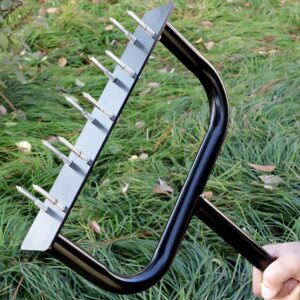Lawn Aerator
A yearly pass with a lawn aerator creates space for air and water to reach your lawn’s roots. This could be the key that unlocks the gate to greener pastures.
3 DAY APRIL SUPER SALE … Don’t Miss Out
-
Sale!

Rolling Aerator | Grass Aerator Roller | Aeration Roller For Lawn
Original price was: $279.$249Current price is: $249. -
Sale!

Aerator Grass Shoes | Lawn Care Shoes
Original price was: $99.$79Current price is: $79. -
Sale!

Manual Lawn Corer | Grass Dethatcher Tool | Step Lawn Aerator
Original price was: $139.$119Current price is: $119.
To find the best lawn aerator for your lawn-care needs and budget, start with our top tips and recommendations.
Maintaining a lawn is demanding, no question about it. Grass requires regular watering, mowing, and weeding to stay verdant and lush. If bare patches persist despite your best efforts, compacted soil is the likely culprit.
Compaction occurs when soil pockets deflate and air, water, and nutrients can no longer circulate around the roots. It often happens in lawns with heavy clay soil and lawns that receive a lot of foot traffic. To make matters worse, drainage suffers as well, and a thick thatch layer—a mix of dead stems, leaves, and roots—often develops between the soil and the grass.
A yearly pass with a lawn aerator creates space for air and water to reach your lawn’s roots. This could be the key that unlocks the gate to greener pastures. Read on for what to look for in a quality tool of this type. Then find out why the models below are among the best lawn aerator options available.
Who Should Aerate Their Lawn
Before you run out and poke holes in your lawn, understand that not all lawns require aeration. But if one of the following scenarios applies to your lawn, you should consider aeration. Otherwise, let the green be.
For newly constructed homes, aeration is almost always a good idea. Between the work crew’s trucks and heavy equipment passing over the soil, there’s a good chance you need to aerate your lawn.
Is your lawn the neighborhood ball field? When a yard sees a lot of use, such as children, parties, pets, and other foot traffic, you should think about lawn aeration.
For lawns built up from sod, a yard aerator can be a necessity. Until the sod can take root and make a connection to the rough soil underneath, it’s just a grass carpet sitting on top of the soil. Lawn aeration promotes that connection.
Your soil may not be breathing because there’s a thick layer of thatch on top. That’s compacted grass, leaf litter, and other materials. In that case, a lawn dethatcher might be all it takes. These tools simply scrape and remove the thatch without digging into the surface.
Aeration Methods
Depending on the method of aeration that’s best for your lawn, you may use one of two types of tools: a spike or a plug (also called a “core”).
Plug Aerators
Plug aerators penetrate the lawn with hollow tines that remove plugs of soil. Home landscapers can either leave these plugs in place to decompose or collect them with a rake or lawnmower.
Candidates for plug aeration include lawns where:
Water pools in the grass or runs off onto sidewalks after a rainfall.
Soil is difficult to dig into.
Frequent foot traffic has hardened the soil.
Whether your lawn has all or just one of these indicators, it will benefit from a plug aerator. The holes create spaces in the soil that allow roots to expand, water to soak in deeper, and air to circulate. The result is a healthy root system below and a lush lawn above.
Spike Aerators
Spike aerators don’t remove soil from the yard. Instead, they puncture the soil with long spikes and allow air and water to reach the roots. They typically work well on less compacted soil and sod. They might not do the trick for dense soil.
Spike aerators tend to work best with looser soil, especially if your goal is to increase root exposure to fertilizer or create spaces for grass seed to settle without running off the soil’s surface.
Types of Lawn Aerators
The size of your lawn and the amount of physical labor you can handle will determine which type of aerator works best for you.
Push Aerators
Push aerators work best in small areas, especially those with obstacles like playsets and trees that require a little finesse to navigate. These aerators most often have spikes, not hollow tines, which make them better suited to lawns without compaction.
A bit harder to find, push aerators require more effort to force the tines into the soil. If the goal is to break down compacted soil, opt for a handheld or tow-behind plug aerator.
Handheld Aerators
Handheld aerator models typically work best on small lawns. They come in both plug and spike varieties. A dual-handle grip (placed high on the tool to prevent back pain) and a strong foot platform allow landscapers to step onto the tool to drive the hollow tines or spikes into the soil repeatedly across the entire lawn. Aeration with handheld tools takes a little more time and physical effort, but it works.
Tow-Behind Aerators
If you have a riding lawn mower, you probably have a large lawn. In this case, a tow-behind aerator might make sense. Connect the lawn aerator to the tow hitch on the mower and quickly cover a lot of ground. To dig deeper, tow-behind aerators come with a tray above the tines for adding extra weight.
Aerator Shoes
Lawn aerator shoes let you aerate the lawn while you walk. But they’re a good idea only for mildly compacted soil and light maintenance. The sandal-like device fits over your shoes with adjustable straps and solid spikes on the soles.
What to Consider When Choosing the Best Lawn Aerator
A nicely aerated lawn can be thick, vibrant and the envy of the neighborhood. But there’s a lot that goes into choosing the best lawn aerator. The following sections break down the most important factors to consider.
Material
Durability is always a factor when shopping for yard equipment. Aerators see particularly rough use as landscapers drive them deep into the ground. For these reasons, the construction materials are an essential consideration.
In general, the best lawn aerator uses stainless, galvanized, or heat-treated steel for the spikes or knives that dig into the ground. These tough materials resist rust and stand up to rocks and other rough terrains. The same goes for shoe-style aerators: stainless spikes are best.
Also, consider the framework of tow-behind aerators. Powder-coated frames, trays, and other components will help resist rust and aerate your lawn for years to come.
Yard Size
When choosing the best lawn aerator, shoppers need to consider whether they’d like to power the aerator themselves or tow it behind a lawn tractor.
Manual lawn aerators, such as the shoe style and the step-on design, require users to repeatedly drive the spikes or knives into the ground and pull them out again. The manual labor may be tolerable for small yards, but large lawns likely need a tow-behind model.
Tow-behind models are by far the most convenient for large lawns, but they do take some time to set up. Users have to attach the aerator to the tractor and place the appropriate amount of weight on top to ensure the spikes penetrate the soil. The right weight varies considerably between lawns, so there are no rules of thumb to follow.
Weight and Mobility
Weight and mobility can be tricky to balance when it comes to lawn aeration. On one hand, an aerator needs to be heavy enough to get into the soil. On the other hand, a bulky, hard-to-maneuver aerator might not be of much use.
Large tow-behind aerators can weigh more than 90 pounds. It’s important that they’re heavy so they can really dig down into the soil. But, they’re hard to maneuver around garden beds, and the setup time might not be worth it.
For those smaller yards, a lighter manual option might be a better fit. These models often weigh less than 5 pounds, which makes them easier to lift out of the soil. They’re incredibly mobile, so they’ll work in the tiniest plots of grass.
Additional Features
Some of the best lawn aerators have additional features which may make them more desirable in certain scenarios.
Knife or spike length. The farther the spikes drive into the soil, the more air and water make it to the roots. But tines that are too long make the aerator difficult to operate. The optimal length is around 3 inches.
Aerator/spreader combs. These models have hoppers that carry seeds and spreaders that distribute the grass seeds while the knives are aerating the soil.
Handle shape. On manual models, look for an ergonomic handle design.

-
WHAT CURRENCY ARE THE PRICES DISPLAYED IN?
All of our prices are displayed in $NZD – New Zealand Dollars
-
WHICH PAYMENT METHODS ARE ACCEPTED?
We currently only accept credit card payments, PayPal & Crypto currency. More payment methods will be added in the future.
-
WHAT ARE YOUR DELIVERY OPTIONS AND HOW LONG WILL IT TAKE?
- NEW ZEALAND: Free delivery, 5-7 days
- Other countries: Free delivery, 7-10 days
OUR DELIVERY PARTNERS

-
DO I GET A RECEIPT FOR MY ORDER?
You will be sent a receipt for your order by email after payment is made. You will also receive a confirmation email with a tracking number once your item has been shipped.
-
I HAVEN'T RECEIVED MY ORDER YET! IS IT LOST?
If you have any concerns with your order, please contact our support team by email and they will be glad to assist you. Most emails are answered within 1 business day.
Support Team: theteam@customersupport.care
-
DO YOU HAVE A SHOP LOCATION?
We are a “online supplier”, with no physical shop or premises. In this way, we are able to pass our considerable savings directly to you.
-
HOW DO I KNOW IF MY ORDER HAS BEEN SHIPPED?
Once your order is shipped, it will be marked as complete in our database and you will receive a confirmation email with a tracking number.
